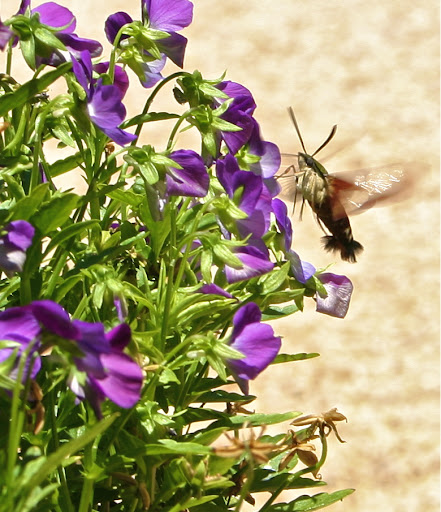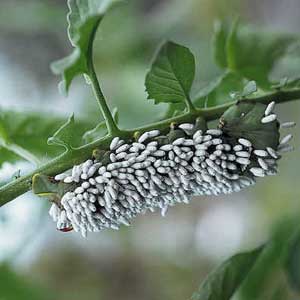
I was thrilled the other day to see what appeared to be a miniature hummingbird buzzing the violas that were still braving this summer's intense heat. Upon closer examination, he appeared to have antennae and legs. A hummingbug? Cool!
On the other side of the garden, I've started having to police the tomato plants for enormous caterpillars which - overnight - can defoliate the entire top of the plant.

I
hate those things! They hold on to the plant when you try to pull them off, spit green juice at you, and have a thorn-type horn at one end which I'm sure they would deploy if I didn't wear my garden gloves!
The detection and destruction of these invaders caused some domestic discord here at the greenwood. I was happy to detect them, not so happy to squash them. I'm squeamish that way. Actually, I should say that I
was squeamish that way. . . . The king had made his refusal to garden well-known, upfront, so I can't really blame him for refusing to help me fight disgusting caterpillars in the garden. I did rather think that he would take pity on my girly sensibilities and dispatch the creatures for me, once captured.
Apparently not.
Feeling very sorry for myself, with the first one I went out, routed the worm, threw him on the compost heap, covered him with a leaf and bisected him with my trowel! No sweat; no muss; no gory details. I then thought about how our society insulates us from most bad stuff to the point where we either deny that bad stuff exists entirely, or run screaming from the room in horror when we can not ignore it. Farmers have no such luxury. A caterpillar chomping on a tomato plant can wreak havoc in a half hour. If you wish eventually to
eat your produce, spraying deadly chemicals on it is probably not the answer. Killing is.
I never really thought I'd come to the point of saying that killing is the answer to anything. This, in spite of the ancient wisdom that there is a time for everything. . . . (and no, having planted even 20 tomato plants does not really qualify me as a "farmer", but I am learning some farmer lessons, I like to think.)
Anyway, I dispatch anywhere from one to six of these things a day now. They can be hard to spot, sometimes, but you develop a knack for seeing them after a while.
Imagine my horror when, instead of the usual green goblin, I got a green guy covered by white egg sacks?!!!

Oh! My! Blech!!!! YUCK!!!! I did NOT want egg sacks in the compost heap. I substituted suffocation by doggie-do bag for trowel bisection. That night, I did some research. What ARE these creatures who have invaded my garden?!
I learned two things. First, the tomato hornworm grows up to be a moth - no surprise there - but it's the "hawk", "Sphinx" or "hummingbird" moth. The hummingbug!!!
Second, if you see the hornworms with the white protrusions on them,
you are not supposed to kill them. Yes, that's correct, folks. Don't kill them because those aren't hornworm eggs on them, they're
wasp eggs! Yay! And the wasps will kill the hornworms! Yay!! So let's have more wasps!!!
. . . like we need more wasps. . . .
Actually, it's a different kind of wasp they're talking about and I have resumed placing the parasitized hornworms in the compost pile. Good luck to those
braconid wasps!And that hummingbug had better stay out of my sight.
By the way, I think that the first full-grown, vine-ripened tomato will come off the vine this evening. It's been a long time - and 3 jumbo containers of cayenne pepper - coming.
 You see the resemblance, I'm sure!
You see the resemblance, I'm sure!








